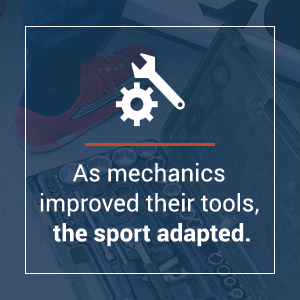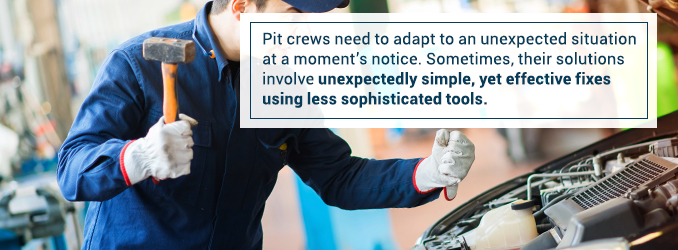Chapter 5: Evolution of Tools and Racing Equipment
One of NASCAR’s most celebrated chief mechanics is Dale Inman, who entered the history books as the man responsible for 198 of Richard Petty’s 200 career wins, including a record-setting seven championship victories.

Inman’s prowess stemmed from a working knowledge of pit crew equipment, having built and turned them on the Fords, Dodges and Plymouths driven by Petty over the course of his 30-year career. The team at then Lee Petty Enterprises was among the first to look at the way tools could be used more effectively.
As mechanics began to make their floor jacks lighter to save on time in transit or modify their air gun sockets with springs so they would automatically eject each lug nut after they were loosened, the sport had to adapt — and adapt it did.
Rubberized fuel cells were introduced in the 1960s to prevent the overflow from pressurized fuel tanks, eliminating the need for the “catch-can man” and simultaneously paving the way for a paradigm shift.
The New Refuelling Regime
Like Inman, Leonard Wood was a chief mechanic and visionary who led his team to victory 96 times in the period between 1953 and 1965. A defining moment came in 1965 when he and his brothers, known as the Wood Brothers, were asked by Ford to service Jimmy Clark’s Lotus 38 in the Indianapolis 500.
As the story goes, an official bet the crew $1,000 they wouldn’t be able to pour 20 gallons a minute with a new gravity-fed refueling system. The team declined the wager of course, but stunned the official when they pumped 58 gallons in 15 seconds during a dry run before the race.
Wood was confident that all pit stops would take place in under 20 seconds and give Clark the edge. Looking back, this was to be a revelation in terms of the way teams could negotiate the rules to their benefit — an aspect which NASCAR actively promotes and encourages.
Pneumatic Tools
Pit crews that learned to work with four-way tire irons and traditional floor jacks were pleased to see the arrival of pneumatic and hydraulic equipment. Their ease and economy of use made some of the more demanding tasks a much more pleasant experience.
In fact, this kind of technology brought the pit crews up to speed and into the modern era. Without it, the unsung heroes of NASCAR may never have had their chance to shine.
Air Compression Technology
The term “compressed air” is somewhat misleading on the track, as the tools used by NASCAR pit crews are not actually powered by air, but rather, by nitrogen. Interestingly, the air we breathe is made up of 21 percent oxygen and 78 nitrogen, so what’s the real benefit of using only the latter?
Nitrogen is more stable than oxygen as it does not undergo oxidization when pressurized. Nor does it have trouble with other heat-related issues, which makes it better suited to the task of powering the crew’s wide array of pneumatic equipment — ensuring they remain functional in suboptimal race-day weather conditions.
Reciprocating Compressors
Also known as piston compressors, reciprocating air compressors have been around since the 1920s when the Quincy Compressor Company opened its doors. In keeping with its philosophy, Quincy has sought to provide their diverse range of clients — most notably across the manufacturing and auto industries — with the highest quality air compressors.
Released in 1939, the company’s QR-25 model became synonymous with superiority and set the standard for durability. Pit crews are still using them to this day for their ability to run at alternate speeds and many would say they’d never dream of using anything else.
Most service stations, fleet maintenance facilities, collision repairers and tire stores are using this type of technology on a daily basis. The series’ success prompted Quincy to expand their product line and offer a greater range to satisfy a growing demand.
Rotary Screw Compressors
Decades later, Quincy unveiled its illustrious QGS series, which offered a more compact design and style. Rotary screw compressors differ from their reciprocating counterparts in a number of key areas, but they are perfectly viable as substitutes at the right horsepower range.
The duty cycle of reciprocating compressors — that is the percentage of time an air compressor may safely operate — remains around 60 to 70 percent. By comparison, rotary compressors have a duty cycle of 100 percent, and can operate continuously without ever running the risk of overheating or burning out.
Maintenance requirements on rotary screw compressors are usually less cost-effective, but the tradeoff is that some of their more desirable components are built into the body. This structure allows them to run much more quietly. For some of today’s pit crews, this is definitely a plus.
Compressed air is involved in every aspect of NASCAR racing, from maintaining and testing the race cars to spray painting their exterior. In addition, rotary screw compressors are perfectly suited to the delicate task of cleaning computer machine parts and pieces, where thousands of dollars could be on the line if cleaned incorrectly.
Whatever needs doing, if it requires a constant airflow, the QGS series will get the job done.
Air Guns and Impact Wrenches
These tools make use of interchangeable sockets that tessellate with the car’s lug nuts, spinning them off with precision at 10 revolutions per second. Additionally, the direction of the impact wrench can be reversed with the flick of a switch, allowing tire changers to work without having to adjust their grip.
Transitioning to this type of technology in the early 1960s contributed to the greatest leap forward in terms of the time it took to complete a pit stop.
Depending on the brand, some wrenches and sockets can be high-cost equipment, and pit crews are careful to look after them.
Other Equipment
As a contact sport, NASCAR drivers are well within their right to drive within inches of other vehicles on the track. It seems incredible that accidents don’t occur with more frequency. But cars do end up on pit road with their fair share of dings and dents.
Pit crews need to be able to adapt to a situation at a moment’s notice. Every so often, this calls for some rather simple and effective solutions using less sophisticated tools.
Hammers and Baseball Bats
Any damage sustained by a vehicle makes pit crews nervous, and drivers are generally expected to pull in or sabotage their chances at staying in the race — assuming there’s time. When all the team needs is a blunt instrument, a hammer or baseball bat will usually suffice.
Although it might appear strange to take a bat to finely-tuned performance machine, a quick fix often goes a long way to making sure the car is able to generate sufficient down force and retain its aerodynamic ability.
Ultimately, if the result gets the car back on the oval, all’s well that ends well.
Jacks and Piano Bars
Piano bars are a different kind of jack that fill a very specific niche. When a vehicle comes off the track riding low to the ground due to severe superficial damage or a flat tire, the elongated bars can slip under the car and lift it just enough to get the floor jack in place.
By using a combination of low and high-leverage jacks when required, a lot of the guesswork is removed from the equation, and pit crews can quickly calculate the most efficient plan of action.
Extension Poles
One tool that is routinely passed over and rarely receives the recognition it deserves is the humble extension pole. The irony is that if NASCAR hadn’t made the ruling that only six people were to go over the wall, this long stick would never have seen as much action as it has.
The utility man on the safe side of the wall can use the pole to complete minor maintenance like cleaning the windshield, removing debris from the grille to improve airflow and/or provide the driver with a quick drink of water.
The most important use for an extension pole is to hold out a sign that alerts the team’s driver to the correct pit area, cutting through the noise of this busy and confusing place. In one fell swoop, any miscommunication is avoided and precious seconds are saved.
Table of Contents
- The Tools of a NASCAR Pit Crew
- Introduction
- Chapter 1: A Brief History of Pit Crew Racing
- Chapter 2: Structure of Race Car Pit Crews
- Chapter 3: Anatomy of the 12-Second Pit Stop
- Chapter 4: The Sports Science Behind NASCAR
- Chapter 5: Evolution of Tools and Racing Equipment
- Chapter 6: Factors Affecting Podium Positions
- Chapter 7: The Future of Pit Crews
- Conclusion: NASCAR as a National Phenomenon





